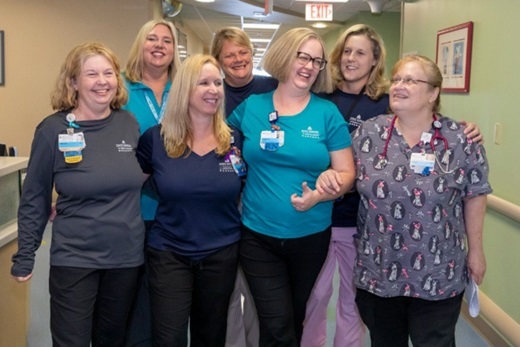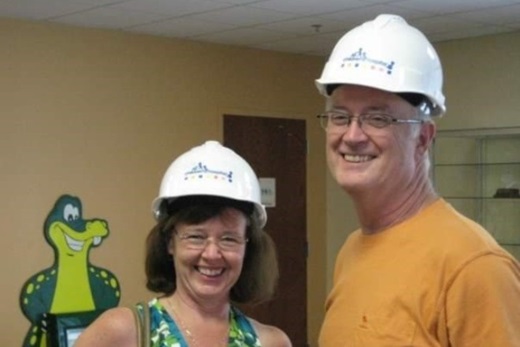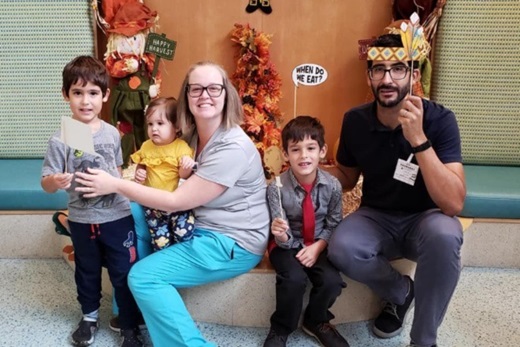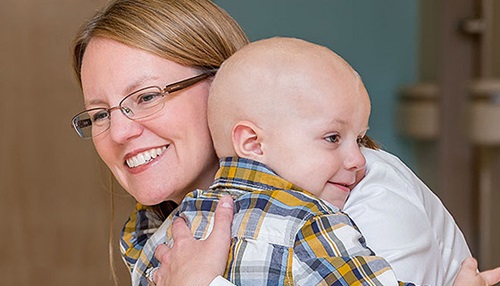Patient Story
Multiple Hereditary Exostoses: Lindsay's Story

Thanksgiving. Christmas. Birthdays. Name the holiday and Lindsay Arenas, R.N., has probably celebrated the day at Johns Hopkins All Children’s Hospital, not only as a nurse though. Her memories of the hospital go back to the 1980s, when her dad, a respiratory therapist, and mom, a neonatal nurse, took a lunch or dinner break to gather with the rest of the family for a makeshift holiday meal or a regular mid-week dinner.
“I have a lot of different memories growing up as a daughter of the hospital,” Arenas says. “I remember my mom setting up a tablecloth in the hospital cafeteria during a lunch break for Father’s Day and coming in almost every Tuesday for Chicken Tampico in the cafeteria.”

She calls her parents, Tim and Debbie Lovelady, the “love story of All Children’s.” They met at the hospital, were married in just a few months, and shortly after, had four kids. They never imagined their family would spend so much time at their workplace and that their children would visit more than just the cafeteria.
First it was Lindsay’s brother, Christopher, who developed a bone growth underneath his arm. Scans revealed it was Ewing’s sarcoma, a rare cancerous tumor found in the bones. Doctors ordered chemotherapy immediately. Around the same time, similar growths appeared in Lindsay.
“When I was in kindergarten, my mom noticed nodules on my legs,” she says. “Fortunately, I had a good place to come.”
Medical tests confirmed Lindsay, and her three other siblings all inherited a rare bone disease, called multiple hereditary exostoses (MHE). For Lindsay, it meant painful nodules in her legs, spinal cord and ribs, eventually leading to 20-plus surgeries in her adolescent and teen years.
“I was a handful, and it was a difficult time in my life,” she says. “I had a lot of issues with pain control after surgery. A lot of the memories I have as a patient were the advocacy of the nurses and other caregivers at the hospital, and their ability to recognize what I needed.”
“I remember taking care of her post operatively, and she was in a great deal of pain,” says Pam Gehrich, R.N., who was one of Lindsay’s nurses. “Due to her extensive surgical history, she understood what to expect, but anticipating the pain was part of the traumatic experience for her. Luckily, I was able to collaborate with her and the entire family. They knew what worked well, and what didn’t work for her pain. I was able to advocate for her throughout my shift, ensuring all of Lindsay’s needs were met and pain was minimal.”
Lindsay inevitably spent a good chunk of her childhood in the hospital until her last surgery at around 19 years old. Her brother successfully completed chemo treatment. Spending their youth in a patient bed may not sound rewarding to most kids, but the hospital made a mark on Lindsay. She knew there was no other place she was supposed to be but All Children’s, so she began training as a patient care technician at the hospital and headed to nursing school.
“When I was going through nursing school, I asked my mom what floor I should work on. My mom told me I should go to 4 south, where I was in the old hospital as a patient,” says Lindsay, referring to the surgical unit. “She felt I could identify with those patients well.”
Her former nurse agreed that the unit needed a nurse like Lindsay on the team, and she hasn’t looked back since. “She understands all perspectives, which has helped her be the great nurse and nurse leader she is today,” Gehrich adds.
Jerry Tuite, M.D., was just one of the Lindsay’s surgeons over the years and says he has been amazed by her progress both as a patient and a professional. “It has been my pleasure and privilege to be her surgeon, her colleague and her friend for more than 20 years,” Tuite adds. “Through thick and thin, I have never seen her rattled. She has extraordinary compassion, maturity, knowledge and tenacity, just like her mom and dad.”

“Everyone on the unit had an impact on me. These people are the strongest, most compassionate, well-rounded nurses. I’m excited to see them and work alongside them every day,” Lindsay says.
Now a clinical manager on the surgical neurosciences unit at Johns Hopkins All Children’s Hospital, Lindsay is making her own impact on young patients. She’s also a mom of three now, with one son who inherited MHE and will most likely be a patient on her unit.
“There is something to be said about knowing he’s going to be in a great place with safe care and coming to a unit that knows him well,” Lindsay says. “I would 100 percent trust every nurse here with my child.”
Pediatric Surgery at Johns Hopkins All Children's Hospital


